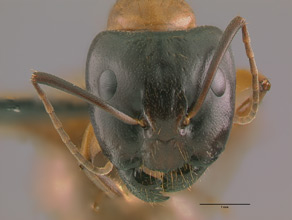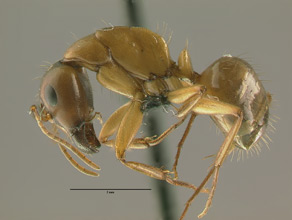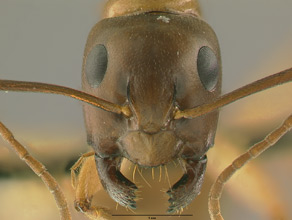- Identification
- Majors of this polymorphic species have wide heads, with the scape just reaching the posterior lateral corner or passing it by less than the length of the first funicular segment. Erect hairs on the head are mostly restricted to the clypeus, but may occasionally be found on other parts of the head, including the sides and ventral surfaces. The base of the scape is flattened and may even be lobe-like. Color ranges from pale yellow to black, most specimens are bicolored with the head darker than the rest of the body (Mackay).
- Biology
- This species is common in pinyon-juniper habits but is also found in sagebrush, oaks woodlands, Ponderosa pine, Chihuahuan pine and rocky outcroppings adjacent to pines. Typically having chambers of their ground nest under stones, Camponotus sansabeanus may also be found nesting opportunistically under other objects on the ground, such as downed wood.
- Distribution
- Range
- United States and Mexico. Mexico - Baja California Norte, Chihuahua, Coahuila, United States - California, Nevada, Utah, Colorado, Arizona, New Mexico, Texas, Missouri, Louisiana, and Arkansas.
- Navajo Reservation Records
- Records being processed.
- Additional Notes
- Etymology
- Geographic. A reference to the location where the types were collected - San Sabas County in Texas.

- Literature
- Buckley, S. B. 1866. Descriptions of new species of North American Formicidae. Proceedings of the Entomological Society of Philadelphia. 6:152-172. PDF
- Mackay, William and Emma - New World Camponotus
- A note about these publications. The literature cited here is not meant to be an exhaustive list of papers published about this species.
Page authored by David Lubertazzi and Gary Alpert



